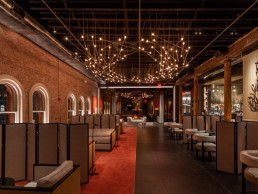
Zero Bond, USA
Zero Bond is an exclusive, high-end, private social club set in the heart of the Noho neighbourhood in New York City. The club was founded by Scott Sartiano, renowned restaurateur, and opened its doors in Autumn of 2020, after a delayed design journey halted by the global pandemic.
The 14,000sqft space exudes elegance with architectural and decorative lighting elements bringing a warm and welcoming atmosphere to the original tall-ceiling architecture of the tradition New York structure.
darc caught up with Brett Andersen, Partner at Focus Lighting, to find out more about their design concept for the club, and how they incorporated decorative features alongside the architectural lighting. “We started work in October 2018, and the project opened in October of 2020 after delays due to the pandemic,” says Andersen. “The goal for the design of this social club was always to use light to celebrate the landmark interior details including the windows and the brick arches, which also create warm and intimate moments for the club members to gather and relax – all within a very open and tall space.”
In addition to the lighting being used to highlight the landmarked architectural shell, it was also important to accentuate the private rooms and clusters of seating to create a hospitality feel due to the exclusive clientele of the club, including celebrities, artists, corporates and more. In turn, this design choice proved beneficial to the post-pandemic world, ensuring visitors could maintain a comfortable distance and sense of privacy between each other.
The architectural lighting elements used in the space included linear white LED strips hidden within the window frames with a paired valance that obscured the fixtures from sight. This allowed the windows to stand out in contrast to the warm accents of light illuminating the seating areas. Recessed, amber-filtered LED uplights with tight beam spreads were used to illuminate the brick arch openings to each room, creating a framed view of each space. In the library, integrated linear shelf lighting highlights the colourful bookshelves and, in the bar, an evenly backlit bar fascia creates a beautiful focal point destination.
Accent lighting was provided in dramatic layers for the sushi bar, which are beautifully mirrored in the highly reflective bar top. Attention to detail in this location ensured the glowing wood texture was cleverly reflected, but not the fixture itself.
Elsewhere, LED strips at the mirrors in the restrooms create a warm halo-effect glow on the curved gold leaf walls, creating an elevated experience.
The standout moment in the lighting scheme comes from the bespoke decorative installation located in the salon. Originally, this piece was planned to feature in the dining space. However, during the initial fitout, the electrician did not provide enough circuits into that area, and the expense of adding more was out of the budget. Thus, the lighting and interior design teams worked on a solution that involved swapping the decorative elements in the dining area with those in the salon. “This ended up being a blessing in disguise as the scale of the salon allowed us to really expand the layout of the decorative piece,” reflects Andersen.
“The large decorative element, manufactured by Sign Expo in New York, comprises more than 80 custom pendants, each consisting of a stem between 4–6ft in length, with a light source at either end. Each end is supported and electrified by a cord that runs to tract fitter above,” he continues. “Focus positioned the track between the deep wood beams above, allowing them to disappear from view. This system design allowed for a very flexible layout, and one that could be changed over time to keep the look of this signature element fresh, year after year.”
In order to achieve a successful installation of the dramatic and complex decorative fixture, Focus Lighting modelled the space in 3D and completed multiple mock-ups of the layout digitally to ensure the install looked great from all angles in the room. “We used that 3D model to map out our installation plan. As this was one of the last elements to be installed, Focus’s team ended up completing the installation, ensuring each pendant was positioned as we mapped them out in our model,” adds Andersen.
The finished piece was a cost-efficient yet bold addition to the deluxe interior design of the social club. Once the sun sets, the decorative fixture fills the volume of the room, adding an element of sparkle.
“The client for this project was fantastic and trusted the design team’s vision from the beginning. We had to come up with creative ways to stretch the available budget to cover the large footprint, while simultaneously giving each area its own unique identity,” he concludes.



